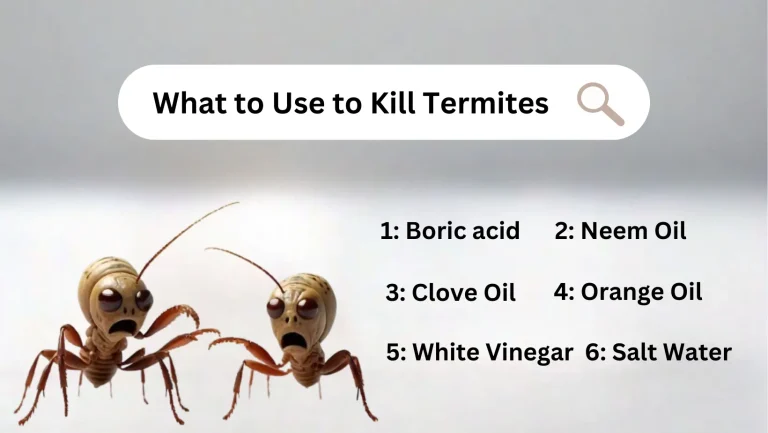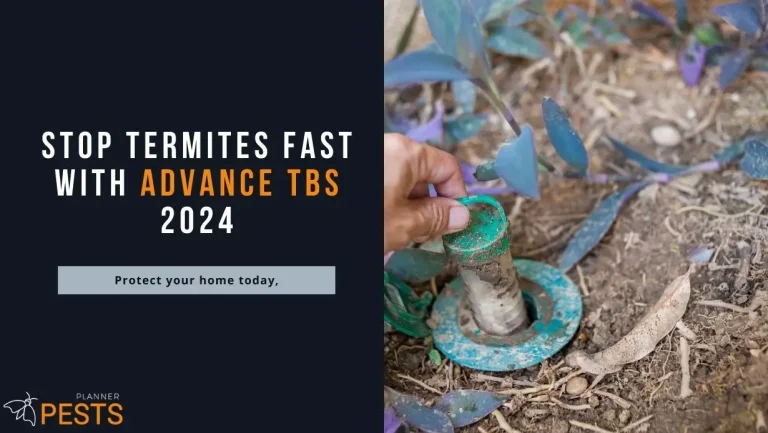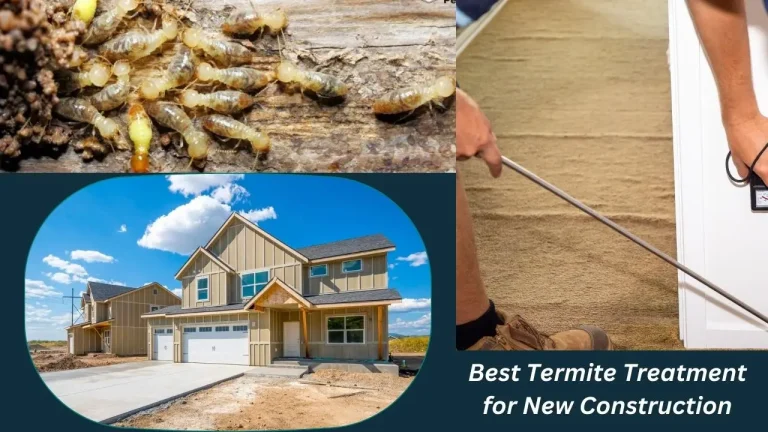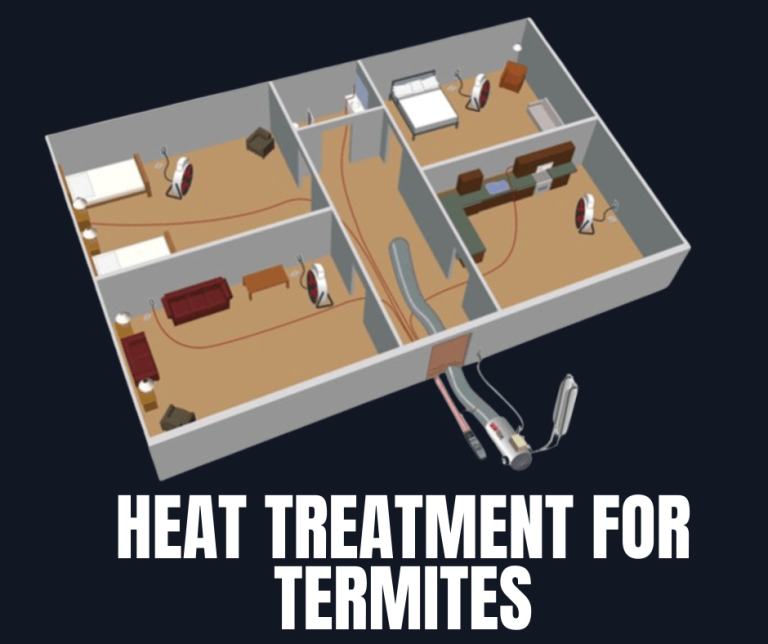No Tent Termite Treatment? Yes, It’s Possible! Here’s How
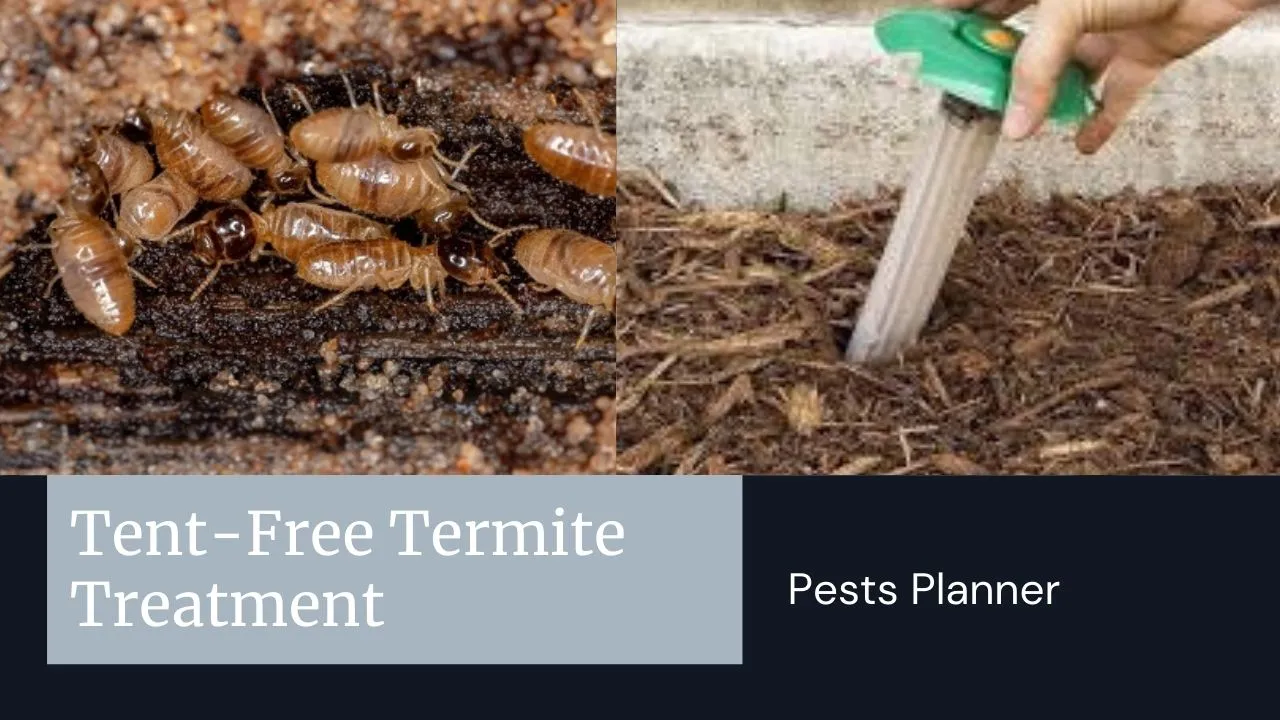
- What is Tent Fumigation for Termites?
- Drawbacks of Tent Fumigation
- How to Get Rid of Drywood Termites Without Tenting
- Termite Spot Treatments
- Termite Wood Injection Treatment
- Termite Bait Systems
- Heat Treatments
- Freezing Treatment
- Benefits of No-Tent Termite Treatment
- When Is Tenting Still Necessary?
- No Tent Termite Treatment Cost
- Finding the Right Pest Control Company
- A No-Tent Termite Treatment Review
- Overcoming Infestations Without Tenting
Termites are among the most common and destructive pests in many parts of the world. These wood-eating insects can cause serious structural damage to homes and businesses if left unchecked. Traditional termite treatment often involves tenting, or covering the entire building with a tarp to trap toxic fumigant gases. But for homeowners looking to get rid of termites without tenting, there are several effective no-tent or “tentless” termite treatment options available.
What is Tent Fumigation for Termites?
Tent fumigation, also sometimes called tenting, has been the go-to method for termite treatment and whole-structure treatment for drywood termites, subterranean termites, dampwood termites, and other termite species. Termite tenting involves encasing the entire home in a tent and pumping it full of lethal gasses to eliminate all life stages of the termite colony (workers, soldiers, nymphs, alates, and the queen), effectively solving the termite problem.
The process usually takes 3-5 days, requiring the homeowners to vacate the premises during the fumigation. All food items, plants, and pets must also be removed. Once the tent is set up and sealed, the fumigation begins, with vents inserted to gradually release the gas once the process is complete. After a thorough aeration, the tent is dismantled and a certification of fumigation is issued once safe re-entry levels are achieved.
Drawbacks of Tent Fumigation
While tent fumigation has traditionally been an effective method for eradicating termite infestations, it has some significant drawbacks:
- Expense – Tenting a structure for termite fumigation often costs $3,000-$5,000 or more
- Displacement – Residents must vacate home for several days, find lodging/coordinate schedules
- Inconvenience -Removing or sealing all furnishings, clothing, food items; extensive prep and post-clearance protocols
- Risk – Fumigants like Vikane gas pose inhalation hazards to people and pets
- Environmental impact – Broad-spectrum fumigants can persist in soil and groundwater
Fortunately, thanks to advances in termite control methods, whole-structure tent fumigation is not the only option for effective treatment. Modern pest control techniques include several tentless or no-tent treatment alternatives that avoid these negatives.
How to Get Rid of Drywood Termites Without Tenting
No-tent termite treatments offer pest control without the disruptive and intensive process of encasing the home, a common practice in Palm Beach. Instead, they use more targeted methods applied directly to known termite infestations and locations vulnerable to attack.
There are now several treatment options for getting rid of drywood termites, dampwood termites, subterranean termites, and other species without tenting. The major types of no-tent treatments include:
- Spot treatments – Applying termiticides directly into galleries or termite nests
- Wood injections – Wood injections and other localized treatments can be an effective part of a comprehensive termite management strategy in South Florida. Injecting insecticides into infested structural timbers
- Bait systems – Bait systems and tent solutions are effective means of addressing termite presence in West Palm Beach homes. Liquid or termite bait stations eliminating colonies over 1-3 months
- Heat treatments– Heat treatments are an alternative to drywood termite control. Heating infested locations to ~135°F to kill termites
- Freezing treatments – Using liquid nitrogen to freeze and kill drywood termites
These no-tent methods vary in their procedures, effectiveness, and cost. But overall, they are designed to avoid the logistical headaches and safety risks of fumigation tenting.
When performed correctly, tentless termite treatments can eliminate termite infestations just as well as tent fumigation, without leaving the toxic residue behind. The key is partnering with a pest control professional to determine the best course of action tailored to your property and the type of termites involved.
Below we’ll take a closer look at the leading types of treatments for getting rid of termites without tenting your home.
Termite Spot Treatments
One of the simplest tentless treatment options is termite spot treatment. This involves applying a liquid termiticide directly into the termite nest itself or other areas where termites are active, an essential step in traditional tent fumigation and drywood termite control.
Termidor and Phantom are two popular termiticides used for spot treatment of drywood termites and are effective in preventing termite swarms. The active ingredient, fipronil, is a non-repellent material that termites cannot detect, making it highly effective against signs of termite activity. Workers ingest it and introduce it to the rest of the colony and queen through their natural social feeding behaviors inside the nest or runway system. This eventually results in full colony elimination.
To prep for spot treatment, a termite inspection using acoustic detectors and other methods locates the current drywood termite infestations on the property, often followed by a free termite inspection. After drilling small holes into damaged wood, the technician sprays the termiticide liberally into the galleries and nests.
Termite spot treatment works well for treating drywood termites within easy reach inside attics, walls, wooden framing, and infested furniture. Whole-house treatment is usually not necessary. One major perk is not having to vacate the home during or after the procedure. There is also no tenting or extensive drilling/destructive remediation needed.
Follow-up inspections may be recommended every 6 months to check for signs of re-infestation. But spot treatments can protect against termites returning for 3+ years when applied correctly. This makes it one of the simplest and most affordable tentless termite treatment options, especially when signs of termite infestation are minimal.
Key Takeaways – Termite Spot Treatment
- Non-repellent termiticides applied directly into galleries
- Effective and affordable single-treatment option
- Low preparation needed and residents can stay in the home
- Best for easy-to-reach drywood termite infestations
- No tenting or whole-structure treatment required
Termite Wood Injection Treatment
Another targeted approach for treating termites without tenting is termite wood injection treatment. This involves drilling into infested structural timbers and floor elements of the home in South Florida to inject an insecticidal solution.
One of the newest termiticides used for wood injections is Altriset. The active ingredient Chlorantraniliprole disables termites’ muscle function, eventually causing paralysis and death. It also impairs their molting process critical for growth and maturation.
An advantage of Altriset injections over old termiticide products is no unpleasant odors or need to drill excess holes into home framing. Treatment holes are sealed after injection to camouflage and preserve structural integrity. Just a few injection points adjacent to active galleries can eliminate nearby termite colonies.
As with spot treatments, a thorough termite inspection first identifies all areas of infestation needing treatment. In addition to framing lumber, wooden elements and furnishings vulnerable to attack are injected. There is no disturbance to residents as fumigants are contained only within targeted injection sites.
Wood injection treatment works well for subterranean termites, drywood termites, dampwood termites, and other species eating into home woodwork. When applied properly, termites tunneling inside walls or floorboards ingest transferred termiticide as they feed, transmitting it back to nestmates and eventually the queen. This tentless method stops most home infestations in their tracks without major disruption.
Key Takeaways – Wood Injection Treatment
- Insecticide injected into infested structural wood
- No odor or excess drilling into framing
- Effective single treatment for all termite species
- Residents need not vacate home
- Targeted application eliminates tenting
Termite Bait Systems
Liquid and termite bait station systems take an entirely different approach to controlling termites without tenting. Instead of applying termiticide directly, bait stations are installed around the interior and exterior foundation. The stations contain non-toxic bait attractive to foraging worker termites who carry it back to share with nestmates.
After termites establish reliable feeding trails into multiple units, the bait matrix switches to a slow-acting compound lethal to termites. Worker termites feed and groom each other, eventually spreading the poison throughout the colony’s members until total elimination (including the queen). This cycle takes roughly 1 to 3 months.
Some termite bait systems like Taurus SC utilize the “chitin synthesis inhibitor” Noviflumuron as the active ingredient. It impairs molting, preventing immature termites from progressing to breeding stages.
Recruit IV is another termite bait brand using food-grade elements like mint oil to quickly attract termites to the bait stations. This system also includes wireless monitoring devices continually checking bait consumption. Once feeding hits target thresholds indicating large numbers, the lethal bait is swapped into place.
These two-step bait methods deliver colony elimination without any drilling or drilling holes for access. Residents need not vacate or prepare the home in any way. Technicians simply place and monitor bait stations – either manually or digitally – until termites are fully eradicated.
Key Takeaways – Termite Bait Systems
- Non-toxic bait in stations attracts and kills entire colonies
- Specialized baits stop molting or gradually poison termites
- Elimination process takes 1-3 months, depending on the extent of termite damage and the effectiveness of the termite activity monitoring.
- No drilling or infestation access needed
- Residents stay in place during treatment
- Stations also prevent future attacks as perimeter guard
Heat Treatments
Heating infested locations is one of the most eco-friendly treatment methods for exterminating drywood termites without tenting. Special equipment raises affected rooms or enclosed areas to temperatures lethal to termites (~135°F) for a designated period. The high heat dries out wooden structures to eliminate termites present while preventing future attacks.
Large heaters and fans circulate hot air through crawl spaces, attics, furniture, and other areas where termites or previous signs of infestation were found. Sensitive electronics and other items are removed or protected before initiating the thermal death cycle. Technicians use sensors to continually monitor wood core temperatures until reaching the target threshold.
Without any chemicals involved, heat treatment poses no health risks to people or pets. Homeowners do need to vacate the premises during the roughly 6-12 hour procedure based on scope. But no further disruption, residue cleanup or other actions are necessary post-treatment since no liquid pesticide remains.
Properly applied heat achieves nearly 100% termite mortality with full colony elimination confirmed through follow-up inspections. This method is EPA-approved and environmentally non-toxic while still preventing future infestations through desiccation.
Key Takeaways – Heat Treatment
- Heats enclosed spaces to 135°F to dehydrate and kill termites
- No use of liquid termiticides
- Eco-friendly/non-toxic treatment process
- Effective for all species without residual chemicals
- Residents vacate home 6-12 hours during procedure
Freezing Treatment
Cryogenic freezing is another emerging chemical-free termite treatment method that avoids tenting. Technicians use liquid nitrogen (LN2) to rapidly lower infested wood temperature to -26°F. They insert LN2 into galleries or nests the way traditional termiticides are applied, freezing termites on contact.
The sudden extreme cold shocks and dehydrates drywood termites’ body systems. Workers, soldiers, nymphs brought in contact perish immediately while cold diffusion eventually spreads to reach nestmates and royalty. This non-toxic treatment tactic provides colony elimination similar to conventional spot treatments.
Freezing treatment is best suited for accessible drywood termite infestations within attics, wooden framing, furniture and other reachable voids. Treatment times range from seconds up to several hours based on the severity and scope involved. Wood and foam insulation highly impacted by termites may also be removed for more effective LN2 application.
While subjecting large areas to freezing methods is not practical, using liquid nitrogen on localized infestations provides an eco-friendly termite treatment with no chemicals left behind. It poses no inhalation irritants or residue hazard concerns compared to traditional fumigation and liquid treatments.
Key Takeaways – Freezing Treatment
- Non-toxic liquid nitrogen freezes termites (-26°F)
- No chemical termiticides used
- Effective on drywood termites in wall voids, attics, etc.
- More eco-friendly than tenting or spray options
- Enclosed treatment sites vacated during procedure
Benefits of No-Tent Termite Treatment
Choosing a no-tent treatment option over traditional tenting provides multiple advantages:
Convenience
- Residents need not vacate home for days at a time
- No prep work removing home furnishings or belongings
- Daily living and routines undisrupted before/after procedure
Cost Savings
- Spot, bait and injection options roughly 30-50% cheaper than tent fumigation
- Focus treatment only on identified sites of infestation vs. entire home
Precision Application
- Direct termiticide/bait contact with galleries and nesting areas
- Heat and freezing also applied only where termites are active
- Minimal drilling and damage to home structure
Reduced Environmental Impact
- Smaller targeted treatment areas involving less chemicals
- Newer termiticides safer for soil and groundwater
- Heat, freezing, bait use no chemicals at all
Improved Safety
- No intensive harsh fumigants used under entire home
- New termiticides have low/no odor and require little PPE
- Bait, heat and freezing treatments non-toxic
When Is Tenting Still Necessary?
- Severe widespread infestations
- Difficult access to primary nest location
- Presence of multiple colonies
- Drywood termites in attics/walls and subterranean termites underneath
- Treatment interference from clutter or stored items
- Desire for full home protection from future attacks
While tentless options like spot, bait, and heat treatment can eliminate localized populations of termites, whole-structure fumigation is sometimes still the most viable route. Cases of large interconnected nests, very heavy infestations, and multi-species presence complicate partial treatments.
Before deciding on full home tenting, a detailed inspection determining the precise locations and severity of attack is a must. Identifying if one or more termite colonies are involved, and what species, guides appropriate treatment plans. From there pros and cons of both tent and tentless methods suited to a property’s scenario can be weighed out.
In certain cases combining termite tenting with follow-up barrier and bait protections delivers the most comprehensive termite elimination and prevention value long-term. An integrated pest management (IPM) strategy tailored to building conditions and needs ensures termites stay gone for good.
No Tent Termite Treatment Cost
The average cost of no-tent termite treatment ranges from $300 to $1,200, Most homeowners pay around 520 per 100-foot house perimeter for liquid termite treatment. The following is a breakdown of different no-tent treatments, along with their estimated cost:
- Bait stations: Placements range from $200 to $400, plus monitoring fees.
- Liquid treatments The cost per linear foot can range from $3 to $16 depending on the size and severity of your home.
- Heat treatment A single treatment can cost between $1,000 and $3,000, depending on how big your home is.
- Foam injection: Treatments range from $500 to $1,000, depending on how large the area is.
Factors affecting the cost of termite treatment without tents:
- Size: the larger your house, the higher the cost of treatment.
- Infestation severity: An infestation that is more severe, indicated by significant termite damage, will require more treatment and will increase the cost.
- Types of treatments: Some no-tent treatments cost more than others.
- Location: Prices may vary based on location.
Tent Termite Treatment Cost
According to the size of your house and the extent of the infestation, the cost of tent fumigation can range from $2,000 up to $4,000. These are a few additional factors that may affect the cost.
- Pretreatment: Before tent fumigation, you may have to pay for moving furniture, covering items, or boarding pets.
- Post treatment: After tent fumigation you may need to ventilate your home for 24 to 48 hours. This could mean that you have to stay at a hotel.
- Monitoring: Some firms offer monitoring services to make sure that termites have been eliminated after treatment.
Tent Termite treatment: Drawbacks
- Tent fumigation costs more than treatments without tents
- It is more inconvenient to have your home tented for 2-3 days.
- Tent fumigation is more dangerous than treatments without tents, making no-tent termite control an attractive option for safety-conscious homeowners.
Conclusion
Your budget and individual needs will determine the best termite treatment. A no-tent option may be the best choice if you have a smaller infestation. If you have a large termite infestation, tent fumigant may be your only option.
Finding the Right Pest Control Company
Choosing pest control technicians wisely ensures proper termite assessment and solutions to permanently resolve infestations. Signs of a reputable termite control company include:
- Licensed instructors – Field staff holding Inspector, Applicator, and Fumigation certificates along with regular training.
- Experience matters – A long track record of effective termite treatments without complications.
- Thorough termite inspection – Uses acoustic, probe, borescope, and thermal imaging methods to pinpoint all infestations onsite.
- Fumigation expertise – Offers both tent and tentless treatment options based on inspection findings.
- Warranties – Backs multi-year re-treatment warranties on termiticide applications.
- Integrated plans – Designs layered treatment plans with different methods as needed for comprehensive protection.
- Eco-products – Features reduced-risk termiticides, thermal, bait and sealing tactics to minimize environmental impact.
Reputable pest control companies focus on long term prevention through addressing conditions promoting infestations, not just chemical treatment. They tailor recommend plans to building construction, moisture issues, surrounding landscape, etc. Education on maintaining a termite-resistant property also adds value for homeowners.
A No-Tent Termite Treatment Review
It can be difficult to find reliable reviews about no-tent treatment for termites. Let’s look at the positive, negative, and sometimes bugging experiences that users have shared to help you understand the buzz.
The Good:
- Convenience is king: Many reviews praise the minimal disruption when compared with tenting. The ability to stay put during treatment is a huge perk. It eliminates the need for temporary housing or moving your belongings, a significant benefit for residents in areas like Palm Beach undergoing tent termite control.
- A targeted attack is good for your wallet: Users prefer the no-tent method because it treats specific areas rather than blanketing their entire home. This can save money, especially if the infestation is small.
- You can breathe easier: Less chemical exposure is one of the most common themes in positive reviews. Users feel safer knowing that they are not exposed to harsh fumigants, which are used in traditional tenting.
- Nature also smiles: Ecoconscious reviewers point out the benefits of using no-tent techniques, reducing harmful chemicals and minimising impact on nearby areas.
- Long term solutions, short term stress: Positive comments are often made about the effectiveness of non-tent treatments for controlling termite issues, providing lasting protection and requiring minimal follow up.
The Bad:
- No one-size fits all solution: Many reviewers are disappointed when they find that their situation is not well-suited to the no-tent method and end up with less than ideal results. A professional assessment by a trained expert is essential.
- Patience can be a virtue. Although convenient, tent-free treatments may require more time and repeat applications than tenting. This can frustrate those who are looking for a quick fix.
- Finding the best fit: All pest control companies do not offer no-tent solutions. It is important to compare and research services in order to find the company that best suits your needs.
- Costs can vary. Depending upon the severity and method of treatment, tenting might not be more cost-effective than no-tent treatments. It is important to compare options and get quotes.
The Buggy :
- Effectiveness Concerns: Some reviewers express concerns over the effectiveness of no tent methods in comparison to traditional tenting. This is especially true for large infestations. It is important to consult a professional.
- Limitations of spot treatment: Although targeted treatments reduce chemical usage, they may not reach hidden colonies and cause future problems. It is important to conduct thorough inspections, and then monitor the colonies, to catch signs of termite activity early.
- DIY Dilemmas: DIY treatments without tents can be dangerous and ineffective. To avoid exacerbating a problem, always rely on professionals to diagnose and treat the condition.
Remember:
- Each review is a reflection of a unique experience that may not be applicable to all situations.
- It is important to consult a pest control expert for an assessment and recommendations on treatment.
- Learn about the limitations of different tent-free methods and their suitability to your situation.
- When making a decision, consider factors such as budget, level of comfort desired, and environmental impact.
Understanding the pros and cons of no-tent treatment will help you make an informed decision about protecting your home against these unwanted guests.
Overcoming Infestations Without Tenting
When tent fumigation is not feasible or desired, modern pest control provides tentative homeowners effective alternatives. Non-disruptive targeted treatments like rodding, foaming, baiting and trapping take out populations without toxic gases or vacating home.
While tenting delivers blanket protection combatting widespread severe attacks, that sledgehammer approach is overkill for many scenarios. Starting with an unbiased assessment detailing scope, species and other factors allows selecting minimal treatment for the situation at hand.
Localized non-tent methods present a reduced risk, less invasive and more eco-friendly solution set for all termite species. They counter the large expense, excessive chemicals and major inconvenience issues withtent fumigation preserving quality of life for residents.
Today’s pest management technology makes tentless termite treatment possible in more situations than ever before. Home and property owners no longer need to automatically default to covering their building for fumigation orvacating for a week when termites strike. Contacting accredited specialists offering both tent and non-tent procedures tailored to infestation specifics brings termite relief with no upheaval.
Key Things to Remember About No-Tent Termite Treatments
- Modern termite control techniques go beyond tent fumigation, using targeted elimination methods focused on identified access areas and nesting sites. Spot treatments, wood injection, bait stations and heat/freezing applications allow treating termites without extensive home sealing and evacuation.
- When performed thoroughly, tentless treatments stop established infestations at least as effectively as tenting in many cases.
- While fumigation maximizes whole-structure protection, it comes at a steep cost premium and lifestyle disruption tentless options avoid. Non-tent methods work perfectly for localized drywood, dampwood and subterranean termite control needs if scoped properly.
- Partnering with a reputable pest control provider offering both tent and no-tent treatment plans ensures picking the best match for building layout, construction, infestation severity, moisture issues, and long-term prevention.
- An integrated pest management (IPM) approach combines tactical treatments eliminating current termites with proactive measures securing the home against future attacks. Expert installation of moisture barriers, chemical soil treatment, wood reinforcement and smart landscaping round out protection following targeted eliminations.


